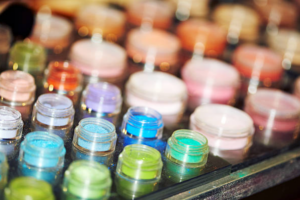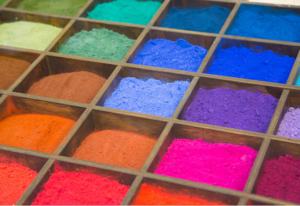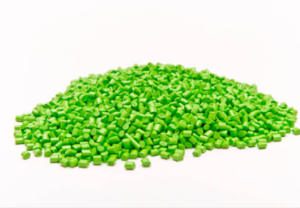The Dark Side of Vibrant Colors

The beauty industry is a kaleidoscope of colors, a realm where every shade imaginable is at your fingertips. Vibrant hues and pigmented products are a cornerstone of the cosmetic world, promising to enhance your natural beauty and allow you to express your individuality. However, behind the dazzling array of colors, there’s a lesser-known component that plays a crucial role in creating those striking cosmetic shades – lake dyes.
Lake dyes are a common ingredient in cosmetics, responsible for the intensity and longevity of many makeup products. In this comprehensive exploration, we will delve into the world of lake dyes in cosmetics, understanding their uses, benefits, and, importantly, the potential drawbacks associated with these powerful colorants.
What Are Lake Dyes?
Lake dyes are created by combining a water-soluble dye with a metal oxide, typically aluminum or calcium salts. This unique combination results in a hybrid colorant with distinct properties. Here’s how the process typically works:
- Water-Soluble Dye: The first component of a lake dye is a water-soluble dye. These dyes can dissolve in water, making them suitable for creating aqueous (water-based) color solutions. Water-soluble dyes are often available in a liquid or powder form and are known for their purity and vibrant color properties.
- Metal Oxide: The second component is a metal oxide, which is a solid inorganic compound. Metal oxides used in lake dyes are typically derived from minerals or other natural sources. They serve as the “lake” part of the dye, which means they render the water-soluble dye insoluble in water.
The Purpose of Lake Dyes in Cosmetics
Lake dyes serve several crucial purposes in cosmetics:
1. Vibrant Colors: Lake dyes are celebrated for their ability to deliver exceptionally vibrant and intense colors to cosmetic products. These dyes can create shades that are bold, bright, and eye-catching, making them a popular choice for makeup artists and enthusiasts. The intensity of lake dyes allows for the creation of striking looks and captivating aesthetics, from rich red lipsticks to highly pigmented eyeshadows.
2. Longevity: Lake dyes contribute to the long-lasting quality of cosmetic products. Due to their stability and resistance to fading, cosmetics containing lake dyes tend to maintain their vivid color throughout the day or evening. This longevity is particularly valuable in products such as lipsticks, eyeshadows, and nail polishes, where color retention is essential for the overall effectiveness of the makeup.
3. Blendability: Lake dyes are known for their ease of blending into cosmetic formulations. They can be smoothly incorporated into creams, powders, and liquid bases, allowing makeup artists and manufacturers to create customized shades with precision. This blendability enables the development of gradient effects, the mixing of colors, and the realization of artistic makeup looks.
4. Versatility: Lake dyes are versatile color additives suitable for a wide range of cosmetic products. From foundations and concealers to blushes and mascara, these dyes can be applied to numerous makeup items. Their compatibility with various bases and formulations makes them a staple ingredient in the cosmetics industry, ensuring that consumers have access to a broad spectrum of colors.
5. Customization: One of the significant advantages of lake dyes is their capacity for customization. Makeup artists and cosmetic manufacturers can experiment with different concentrations and combinations of lake dyes to achieve unique and tailor-made shades. This freedom to create personalized colors empowers creativity in the makeup world and allows for the development of distinct looks and products.
6. Blendable Gradient Effects: Lake dyes are exceptional for producing gradient or ombre effects in cosmetics. These effects involve smoothly transitioning from one color to another, creating visually appealing and artistic results. Lake dyes can be manipulated to blend harmoniously, allowing for intricate designs and innovative makeup techniques.
7. Availability of a Wide Color Spectrum: Lake dyes offer access to a broad spectrum of colors that are not always attainable with other types of color additives. Whether it’s a vivid turquoise eyeshadow or a deep burgundy lipstick, lake dyes provide the vividness and diversity needed to cater to a wide range of consumer preferences and makeup trends.
8. Consistency Across Product Lines: Lake dyes can help cosmetic brands maintain consistency in color across their product lines. This is particularly important for brands that offer multiple products in the same shade. By utilizing lake dyes, companies can ensure that a specific color, whether a signature red or a unique pastel, remains consistent across their lipsticks, nail polishes, eyeliners, and more.

The Controversy Surrounding Lake Dyes
While lake dyes offer many advantages in terms of color vibrancy and stability, their use in cosmetics has not been without controversy. Let’s explore some of the concerns associated with these colorants:
- Allergenic Potential: Some individuals may be sensitive or allergic to specific lake dyes or their ingredients. Allergic reactions can range from mild skin irritation to more severe responses like itching, redness, or swelling. Therefore, it’s important to perform patch tests or check product labels for potential allergens before using cosmetics containing lake dyes.
- Heavy Metal Concerns: The metal oxides used in the creation of lake dyes can contain heavy metals like aluminum or barium. While these metals are generally considered safe in small quantities, long-term exposure to heavy metals can lead to health issues. It’s crucial that cosmetics containing lake dyes adhere to regulatory guidelines and safety standards to minimize heavy metal exposure.
- Limited Transparency: The lack of transparency in disclosing the specific lake dyes used in cosmetic products can make it challenging for consumers to make informed choices. Companies are not always required to provide detailed information about color additives, making it difficult for those with allergies or sensitivities to avoid certain dyes.
- Environmental Impact: The production and disposal of cosmetics containing lake dyes can have environmental implications. Proper waste management and recycling practices are essential to minimize the environmental footprint of cosmetic products.

The Role of Regulation in Lake Dyes
In the United States, the use of lake dyes in cosmetics is regulated by the Food and Drug Administration (FDA). Cosmetic manufacturers are required to adhere to FDA guidelines and label their products accurately, listing all ingredients used, including color additives.
The FDA has established safety standards and permissible levels for color additives, including lake dyes, to ensure that they do not pose health risks when used as directed. However, it’s crucial for consumers to be informed and make conscious choices when selecting cosmetics, especially if they have known allergies or sensitivities to specific colorants.
For those who want to enjoy the benefits of cosmetics while minimizing potential risks associated with lake dyes, here are some useful tips:
- Read Labels: Always read the ingredient labels of cosmetics to identify any lake dyes or color additives that may be problematic for your skin.
- Patch Test: Perform a patch test on a small area of skin before applying a new cosmetic product, especially if you have sensitive or allergy-prone skin.
- Research Brands: Choose brands that prioritize transparency and adhere to safety regulations. Research companies that share their commitment to product safety and the responsible use of color additives.
- Understand Your Sensitivities: If you have known sensitivities to specific dyes or ingredients, make a list of substances to avoid, and cross-reference it with product labels.
- Support Sustainable Practices: Look for brands that prioritize sustainability and environmentally friendly packaging and production methods.

Lake dyes play a vital role in the beauty industry, enabling cosmetic manufacturers to create vibrant and long-lasting makeup products. However, their use is not without concerns, particularly when it comes to allergenic potential and heavy metal content. As consumers, it’s essential to stay informed, read product labels, and choose cosmetics from brands that prioritize safety, transparency, and responsible practices.
The key to enjoying the benefits of lake dyes in cosmetics is making informed choices, understanding your sensitivities, and supporting brands that align with your values and safety concerns. By doing so, you can continue to explore the colorful world of cosmetics while minimizing the risks associated with these powerful colorants.

